Memoir of a Homebrew Computer Club Member
By Bob Lash
bob@bambi.net
Last Update: March 28th, 2016
My first exposure to computers was at age 6 (1963), as a subject in Dr. Patrick Suppes' accelerated
mathematics experiment at Stanford. I was taken to a small room with
what I now know was a CRT display and an intercom. I was asked to push some
keys in response to some shapes on the screen. Afterwards, they showed me
around a large room filled with big cabinets, some with lots of blinking
white lights.
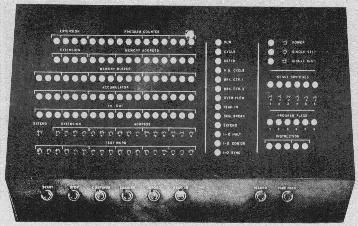 They said it was a "computer" and its name was the "PDP-1". A tall thin man
asked me to hit a key on a console to make a "decktape". I had absolutely
no idea what a "DEC tape" was at the time, but when I hit the key, a small
pair of reels BEGAN TO TURN!! It was a moment I would never forget.
They said it was a "computer" and its name was the "PDP-1". A tall thin man
asked me to hit a key on a console to make a "decktape". I had absolutely
no idea what a "DEC tape" was at the time, but when I hit the key, a small
pair of reels BEGAN TO TURN!! It was a moment I would never forget.
By age 10 I began constructing all kinds of electronic hobby projects,
and had also done some soldering of "Flip Flop"
boards (with my first cousin, Arnold Gold) for a friend of his father's
named Burt Libe (Some of
these boards wound up as part of a "sound tree" exhibit which is still in
operation at the Exploratorium in San Francisco.
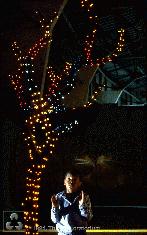 A visitor would clap his hands or speak, and a colorful wave of light
would sweep up the tree.) I also built model rockets (this was still the
age of Apollo) and through that hobby learned of Micro Instrumentation and
Telemetry Systems: MITS (they were selling flashing light kits for night launches
of model rockets, but no Altair yet.)
A visitor would clap his hands or speak, and a colorful wave of light
would sweep up the tree.) I also built model rockets (this was still the
age of Apollo) and through that hobby learned of Micro Instrumentation and
Telemetry Systems: MITS (they were selling flashing light kits for night launches
of model rockets, but no Altair yet.)
Back in 1973 I was an energetic Palo Alto High School student who had recently
become a student System Operator for the PAUSD school district's HP2000F
32-user BASIC timeshare computer system (under the direction of Dr. Bruce
Keepes), which was later upgraded to a prototype HP3000.
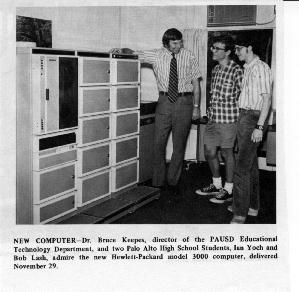
The HP2000F had a bank of 110 BAUD modems (10 characters per second) for
teletype dial-ups, as well as "Fast Ports" at 300 BAUD. One afternoon I was
at the People's Computer Center
and used one of their ASR 33 teletypes with an acoustical
coupler (you actually put the telephone handset into a cradle on the slanted
face of the teletype) , dialed in, and had an online "chat" with fellow HP2000F
system operator Greg Dolkas (who later went on to work at HP, I understand).
The People's Computer Center was a really cool place for computer hobbiests
at that time -- as you see in the printout, they had a
PDP-8/E, PDP-8/L, and 4 ASR 33 teletypes... the best public access for "real
people"!
Posted on a bulletin board in the PALY terminal room (containing 6 noisy
KSR-33 teletypes in the Palo Alto High School math-science office) was a
notice that a computer group meeting would be held at the home of Gordon French. I
jotted down the notice's announced date and location onto the back of an envelope (how
appropriate!). Mike Fremont (another
student System Operator) and I both attended this first meeting in Gordon
French's garage. Ralph
Campbell (also from PALY) attended as well. We were the three youngest
ones there, and rather shy and quiet (as I still am today), but were absolutely
astounded when Gordon let us step into his house and see his 8008 system using
16K of SHIFT REGISTERS (!) as memory and his very own teletype (unlike random-
access memory, his system actually shifted the data in a ring and WAITED
until the desired address came up for data read/writes! We were extremely
impressed.).
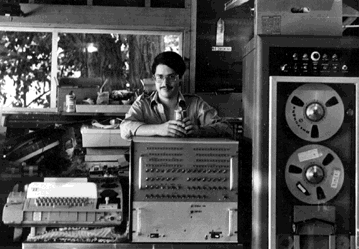 The excitement at homebrew was electric, and during the period of '74
to '76 I constructed a working 12-bit microprogrammed minicomputer (see photo)
using a 30-bit micro-control store entirely out of about 100 SSI/MSI TTL wire-wrapped
chips, which (thanks to the understanding of my wife) I still have in the
garage. My cousin Arnold Gold often sat in the freezing garage with me late
at night helping with the wire-wrapping. No microprocessor chip was used
initially because as a kid, using 4004's or an 8008 was prohibitively expensive.
(I was working as a "soda jerk" at Edy's across the street from the Stanford
Campus along with three lawn mowing jobs to pay for parts. One night, after
returning home from Larry Page's with a tiny little bag of 256 bit (BIT,
not K) ram chips my mother, in a shocked tone, said "That's what your month's
pay went into??!!" ). The front panel has about 100 incandescent lamps (Gordon
thought these were especially neat when he came over for a demonstration)
and 56 toggle switches. It was hooked to an ASR-33 which I reconstructed
from 3 junked teletype chassis given to me by a friend, David Bell. (This
was a BIG improvement over the Model 17 teletype he pawned off on me earlier,
which while indestructible, dimmed the lights in my garage, leaked blue sparks
from its typing distributor, suffered from the handicap of 5 bit BAUDOT code
instead of ASCII, and apparently was taken out of service by a newswire service
in the 1930's.)
The excitement at homebrew was electric, and during the period of '74
to '76 I constructed a working 12-bit microprogrammed minicomputer (see photo)
using a 30-bit micro-control store entirely out of about 100 SSI/MSI TTL wire-wrapped
chips, which (thanks to the understanding of my wife) I still have in the
garage. My cousin Arnold Gold often sat in the freezing garage with me late
at night helping with the wire-wrapping. No microprocessor chip was used
initially because as a kid, using 4004's or an 8008 was prohibitively expensive.
(I was working as a "soda jerk" at Edy's across the street from the Stanford
Campus along with three lawn mowing jobs to pay for parts. One night, after
returning home from Larry Page's with a tiny little bag of 256 bit (BIT,
not K) ram chips my mother, in a shocked tone, said "That's what your month's
pay went into??!!" ). The front panel has about 100 incandescent lamps (Gordon
thought these were especially neat when he came over for a demonstration)
and 56 toggle switches. It was hooked to an ASR-33 which I reconstructed
from 3 junked teletype chassis given to me by a friend, David Bell. (This
was a BIG improvement over the Model 17 teletype he pawned off on me earlier,
which while indestructible, dimmed the lights in my garage, leaked blue sparks
from its typing distributor, suffered from the handicap of 5 bit BAUDOT code
instead of ASCII, and apparently was taken out of service by a newswire service
in the 1930's.)
Gordon French reconnected with me (thanks to the Net!), and I was amazed
to learn he technically still holds the position of Secretary of Homebrew!
He is in the process of collecting up some of the early notes and newsletters
for scanning, and sent me this page (click on excerpt below) from his notes
about the meeting... it also announces that our next meeting would be held
at Peninsula School:
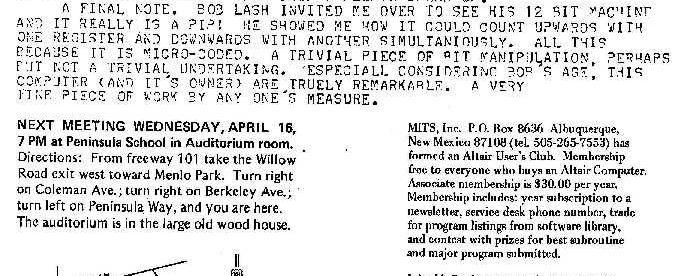
Gordon is also still active as the Chairman of a model engine builder's
group.
Remember those paper tapes? Well, with the right incantations, the ASR-33's
balky paper tape reader could usually be coaxed to load the bootstrap:  I wrote an assembler and compiler for it. The compiler was called FABOL, for "Fortan-Assemby-Basic
Oriented Language". I later donated the Burroughs tape drive (which I inherited
from homebrewer Carl Kelb
- RC Engineering) to the Foothill College Electronics Museum.
I wrote an assembler and compiler for it. The compiler was called FABOL, for "Fortan-Assemby-Basic
Oriented Language". I later donated the Burroughs tape drive (which I inherited
from homebrewer Carl Kelb
- RC Engineering) to the Foothill College Electronics Museum.
The second meeting of Homebrew was held in an old school house, and Steve
Dompier brought in his Altair, and put a transistor radio on top of it. To
everyone's utter amazement, it actually played "Fool On The Hill" by picking
up buss harmonics and running a clever timing loop. I was astonished! Not
long after I used this idea, and hooked a speaker directly to an open-collector
driver that was on an incandescent monitoring lamp of the LSB of one of my
machine's registers. After toggling the timing loop in, it was playing tunes
(although a bit off key). It was cool!
Ralph Campbell
constructed an early Altair (#220218) and humorously placed an "OBSOLETE"
sticker on it's front panel. Tiring of toggle switch flips, he wire
wrapped his own CPU board with EPROM monitor and video display. Ralph later
contributed to the creation of RISC I & II architecture at Berkeley (which
led to SUN's SPARC architecture, among others) and went on to become one
of the principal developers of Berkeley UNIX (BSD 4.2, 4.3, and 4.4) and
BIND (DNS).
John Draper (a.k.a.
"Captain
Crunch") attended meetings regularly, and was working for Call Computer.
Homebrewers were treated to free copies of the Silicon Gulch Gazette.
In 1976 Steve Wozniak gave
me a copy of his 6502 floating
point math routines which I laboriously typed byte-by-byte onto paper
tape late into the night. I had by then added a 6502 chip to my system to
function as its floating point processor(!). The thrill of actually seeing
it all work was indescribable.
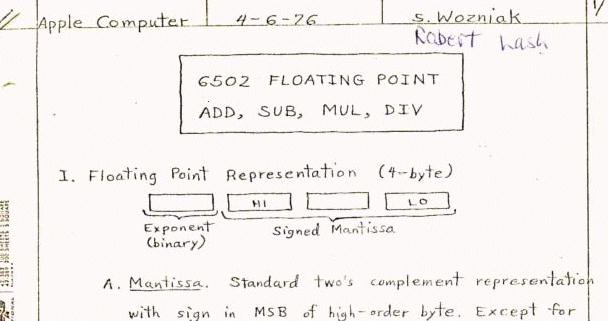
Marty Spergel (M&R Electronics) was talented at getting parts for other
homebrew members, and helped organize some group purchases. He was a really
nice guy, as I recall.
Gordon French was always warm and sincerely interested in what everyone
was doing. I suppose I viewed him as a sort of "father figure" (the age difference
was great, and his silvery hair contributed to the effect), even though in
terms of building systems, we had become peers.
Lee Felsenstein, who designed the Pennywhistle Modem and later developed
the SOL computer (along with Bob Marsh) at Processor Technology, led the later
meetings.  We became so big we had to use the auditorium at SLAC (the Stanford Linear
Accelerator Center). My cousin Arnold Gold eventually purchased a SOL, and
I had the opportunity to write code for it -- a scheduling program for a
(fully legitimate) Mushroom Farm! It was a really nice machine, and I am
convinced if they had the capital to have put it into an industrially-designed
plastic case (rather than the stereo-like woodgrain case) they might have
become another Apple Computer. Here is a schematic from the SOL, that
was checked by Lee and approved by Bob Marsh.
We became so big we had to use the auditorium at SLAC (the Stanford Linear
Accelerator Center). My cousin Arnold Gold eventually purchased a SOL, and
I had the opportunity to write code for it -- a scheduling program for a
(fully legitimate) Mushroom Farm! It was a really nice machine, and I am
convinced if they had the capital to have put it into an industrially-designed
plastic case (rather than the stereo-like woodgrain case) they might have
become another Apple Computer. Here is a schematic from the SOL, that
was checked by Lee and approved by Bob Marsh.
The only member of Homebrew I remained in touch with was Mike Fremont (Mike
later authored a program called MemoryMate for Broderbund, has 2 kids (I
have 1) and worked together with me for a number of years at WebChat).
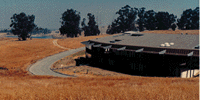 Mike and I occasionally "snuck in" to the Stanford
AI lab, where invariably someone would let us play lunar lander on a
big graphics terminal, or watch a simulated robot arm stack geometric shapes.
The "cart" robot never seemed to be running. One night a student very proudly
showed us a large rack mount cabinet that contained "one million words" of
memory for their
PDP-10. We were completely wide-eyed. (Attention PDP-10 enthusiasts: Paul
Allen has obtained a TOAD-1 PDP-10 architecture machine, and is giving out
free telnet accounts to anyone
who wants to run their PDP-10 code on it!)
Mike and I occasionally "snuck in" to the Stanford
AI lab, where invariably someone would let us play lunar lander on a
big graphics terminal, or watch a simulated robot arm stack geometric shapes.
The "cart" robot never seemed to be running. One night a student very proudly
showed us a large rack mount cabinet that contained "one million words" of
memory for their
PDP-10. We were completely wide-eyed. (Attention PDP-10 enthusiasts: Paul
Allen has obtained a TOAD-1 PDP-10 architecture machine, and is giving out
free telnet accounts to anyone
who wants to run their PDP-10 code on it!)
We also were able to get onto the ARPANET using a "TI Silent 700" thermal
paper terminal at HP (we met there at night as part of an Explorer Scout post),
playing chess via telnet to a computer in LONDON! In those days you had to
either be at a defense contractor's office or an educational institution
to get on to the net (times have certainly changed much for the better!).
We also would frequently go down to Tressidor student union to play Space
War (it was rumored, to our utter amazement, that it actually had a REAL
PDP-11 inside) and get a soft drink and chips.
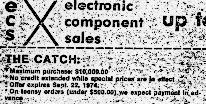 In 1974, Mike and I got swindled by ordering parts at prices that were "too
good to be true". This ad for "ECS" appeared in the September 9th, 1974 Electronic
News, which stated "The Catch: ... On teensey orders (under $500.00)
we expect payment in advance." Mike ordered an 8080 chip (costing hundreds
of dollars) which never arrived, and I ordered some 2602B 1K X 1 static RAM
chips, which DID arrive, but in dip packages with bottom painted part numbers
and the WRONG NUMBER OF PINS! I understand the "proprietor" left town.
In 1974, Mike and I got swindled by ordering parts at prices that were "too
good to be true". This ad for "ECS" appeared in the September 9th, 1974 Electronic
News, which stated "The Catch: ... On teensey orders (under $500.00)
we expect payment in advance." Mike ordered an 8080 chip (costing hundreds
of dollars) which never arrived, and I ordered some 2602B 1K X 1 static RAM
chips, which DID arrive, but in dip packages with bottom painted part numbers
and the WRONG NUMBER OF PINS! I understand the "proprietor" left town.
I entered UC Berkeley in 1975, and wound up attending homebrew meetings
less and less frequently. It became harder and harder to spend long nights
writing code and building more "projects" to add to the system. By the time
I was in medical school at UCSD, I had lost touch with this treasured part
of my life. My last conversation with Gordon French was about '79 (until
we reconnected in 1999, that is!). Apparently he was approached by someone
at US Magazine writing a story about young computer buffs and gave them my
name. But it turned out they were only looking for buffs still under 21.
In '82 I wrote a TINY LOGO
interpreter which was published by a Canadian based software house, for the
ill-fated TIMEX/SINCLAIR computer. I thought that this $49 computer that
could run BASIC would really be a hit, but it became clear that the average
buyer wasn't really interested in programming at all. (I took some inspiration
from Tom Pittman who wrote TINY BASIC back in homebrew,
and demonstrated that you could run a nice little interpreter in a tiny amount
of program space).
After medical school I wound up as a medical device developer at a company
which I formed in 1984 with another young physician who was also an engineer.
We raised initial capital and developed a number of innovative computer based
medical devices in the areas of laparoscopic general surgery as well as plastic
surgery. In 1989 the company licensed its patent for a female condom device
to a spinoff company, and I left to become its President to pursue the development
of this product. We raised additional capital and successfully completed
the first two phases of FDA studies, however we were unable to raise the
capital for the final phase of testing.
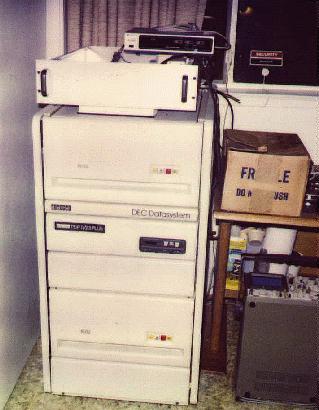 I then became the proud owner of a PDP 11/23-PLUS, running RT11 and MACRO-11.
If you enjoy the PDP-11, you can show your support by joining the PDP Unix Preservation Society.
I then became the proud owner of a PDP 11/23-PLUS, running RT11 and MACRO-11.
If you enjoy the PDP-11, you can show your support by joining the PDP Unix Preservation Society.
I subsequently joined a company founded by Mike Fremont called Fun University
Network (which changed its name so many times, I thought it would be amusing
to list them all here: Learning Things, Gecko Learning Products, Brainstorm
Software, Fun University Network (FUN), Springboard, Internet Roundtable Society,
WebChat Communications, and finally WebChat Broadcasting
System (WBS) !) and have been involved in the development of innovative
online applications and services since that time. We went on to operate one
of the largest community web sites in the world (WBS),
which was then acquired by Infoseek and subsequently integrated into Disney's
GO.com. Mike started a new company which I joined, called Zorch, to
develop an educational gaming web site. Two years later I joined a
company founded by Dave Morse (who founded Amiga Computer) called Driving Media, where I served
as its VP of Engineering. I am currently VP of Engineering at ViOptix.
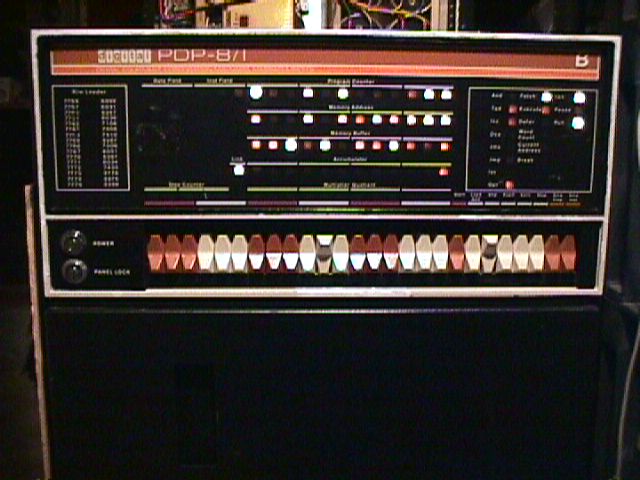
In mid-1999 Mike Fremont and I acquired an inoperative Digital PDP-8/I, and
with the help of Mike Fox we restored it to working order (notice the machine
happily blinking its lights here!). About 22 burned-out incandescent lamps
were replaced, along with damaged power cabling, a cracked back plane power
bus, and a flaked out power supply. It has 8K of CORE memory, and can run
at nearly a blazing 1 MIPS. We established remote Internet connectivity
in which we telnet to a Linux box, and from there connect to the 8's teletype
console. The machine now runs 4K Chess (!) along with FOCAL 1969.
Even though the Homebrew Computer Club disbanded in 1986, the spirit of
Homebrew lives on! You can still see the same excitement in the eyes of young
folks today when they begin to explore the wonders of computers and the Internet,
stretch their imaginations, and look to the future.
A Homebrew
Computer Club reunion was held on March 5th, 2001 at SLAC (thanks to the
efforts of the Stanford-Palo Alto
Macintosh Users's Group) and many of the "Homebrew 3/5/75 Originals" attended
(see the program and Gordon French's guest list here).

(Photo of "Homebrew Originals" courtesy of Henry Polard. Special thanks
to Fred Balin of SMUG.
From left to right: Front Row: Len Shustek, Gordon French, Marty Spergel,
Bob Lash (myself), Ralph Campbell, Mike Carlisle, Walter Bryant, George Oetzel,
Harry Garland, Allen Baum, Lee Felsenstein, Dennis Allison (head turned),
Gene Wallace. Back Row: Roger Melen, Bob Marsh, Fred Balin [who is mostly
hidden]) .
Gordon French (second from left) is conversing with Lee Felsenstein (far
right in white shirt), both armed with wireless microphones. Len Shustek co-founded
Network Associates and is now chariman of the Computer Museum History Center.
Here is a larger version of the photo (342K JPEG).
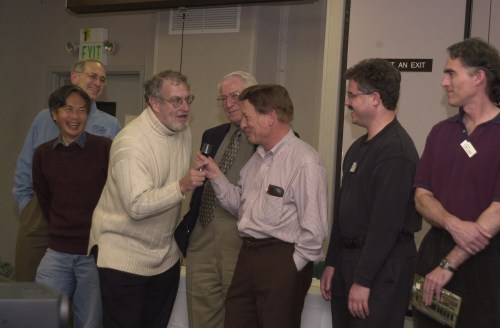
(Photo courtesy of Susan Bradley).
John Draper (a.k.a. "Captain Crunch") joins in. To the left is Lichen
Wang, who is highly respected for his graphics work on the Dazzler
Altair color display. Ralph is holding an Altair CPU board he constructed
in Homebrew. Here is a larger version (1.2 MB JPEG).
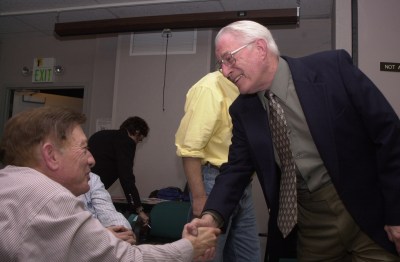
Marty Spergel and Gordon French reunited.
(Photo courtesy of Susan Bradley). Larger version (1.2 MB JPEG).
It was really wonderful to see Gordon and so many other familiar faces
again. Ralph Cambell is now at SUN, and John Draper is involved in Firewall
security products.
Dan Sokol, an original homebrew member, came by to visit me (and my homebrew
machine, of course!) on October 16, 2004 as part of an interview with a Japanese
journalist who was writing a book about the history of the PC. Dan
was one of the few members actually in the semiconductor industry during
the early days of homebrew, and he shared information (and help getting components!)
with the group. This photo of Dan
Sokol (bottom right) and myself (plus the homebrew machine, as well as
a running PDP-8/i actively playing chess on its KSR-33 teletype, and a PDP-11/23+)
is courtesy of Shigeyuki Koide.
A Homebrew
Computer Club 30th Anniversary Retrospective panel was organized by the
DigiBarn at the 8th Annual Vintage Computer Festival
(VCF 8.0) on November 5th, 2005:
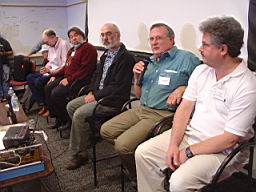
Homebrew Panel at the Vintage Computer Festival 8.0
(Photo courtesy of the DigiBarn).
Larger version (394 K JPEG).
From left-to-right: Michael Holley, Steve Wozniak, Allen Baum, Lee Felsenstein,
and Bob Lash (myself). Len Shustek joined us via Lee's quick hack of rigging
his cel phone to a microphone.
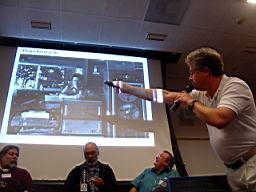
(Photo courtesy of the DigiBarn).
Larger version (302 K JPEG).
As Lee did not seem to have his usual stick handy, I resorted to a screwdriver
to point out features on my homebrew computer. Allen and Steve look over
a freshly located laser pointer as a possible hardware upgrade.
From left-to-right: Steve Wozniak, Allen Baum, Lee Felsenstein, and Bob
Lash (myself).
For full details about the 30th Anniversary event, complete with audio,
video, and cake cutting, please see the Digibarn
Homebrew@30 site.
A Homebrew
Computer Club 38th Anniversary Reunion was held on November 11th, 2013
at the Computer History Museum in Mountain View, organized by Lee Felsenstein,
Hilda Sendyk, Matt Spergel, Joel Franusic, and Michael Selvidge through a
kickstarter
campaign. This was our largest reunion yet, with over 100 Homebrew
members attending (!), and an even larger number of kickstarter supporters
there as well.
Matt Spergel has put together an excellent web page about the event entitled Setting the Record Straight: The Untold 'Love' Story Behind the 2013
Homebrew Computer Club Reunion complete with photos along with Matt's recollections and personal anecdotes about many of the members.
A program was distributed which organized the meeting
into an auditorium event, followed by the traditional "random access" period
for people with like interests to gather together, look at equipment attendees
had brought in, and share thoughts.
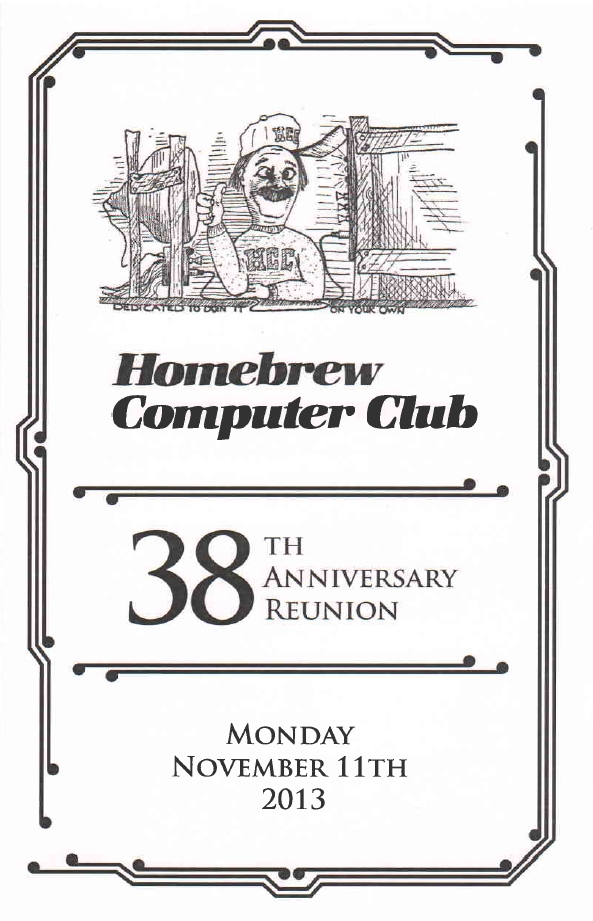
In keeping with Homebrew tradition, Lee Felsenstein led the meeting from
the front of the room. Here Lee is listening to Steve Wozniak speak:
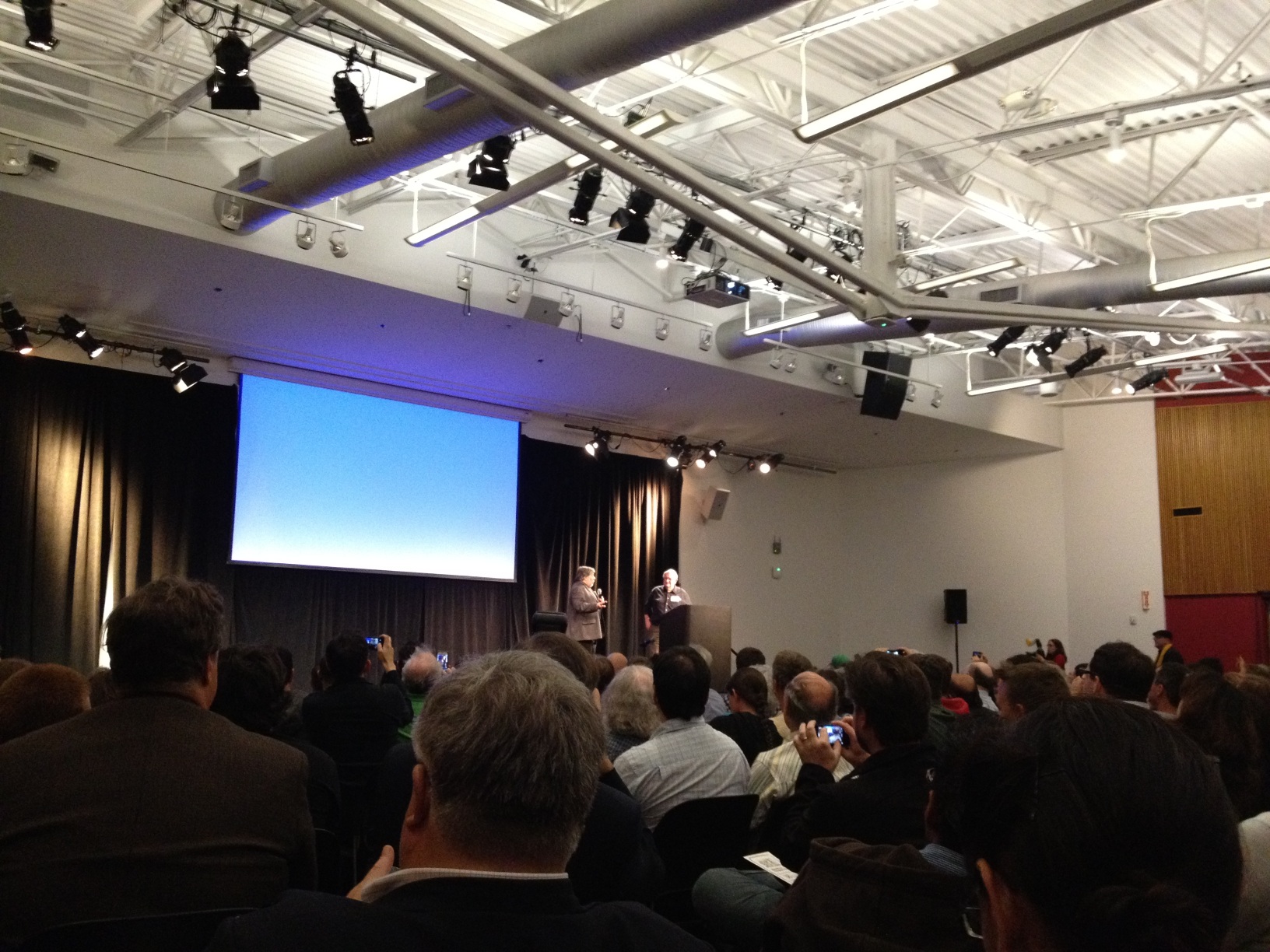
Also in the tradition of Homebrew, newcomers were welcome to share their
thoughts and become part of the Homebrew group. In the foreground is my son,
Eliot Lash who attended with me.
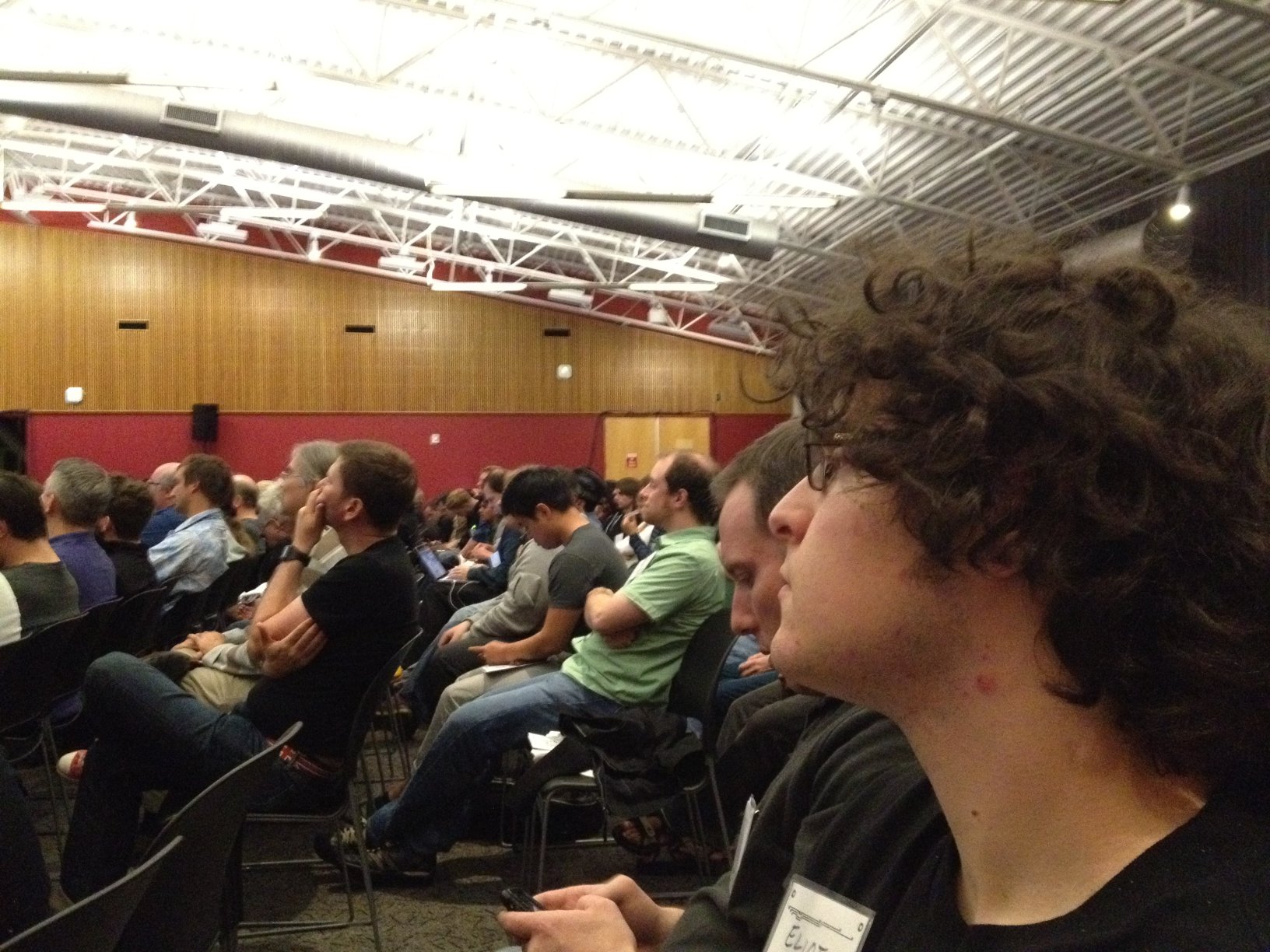
Marty Spergel attended by robotic telepresence:
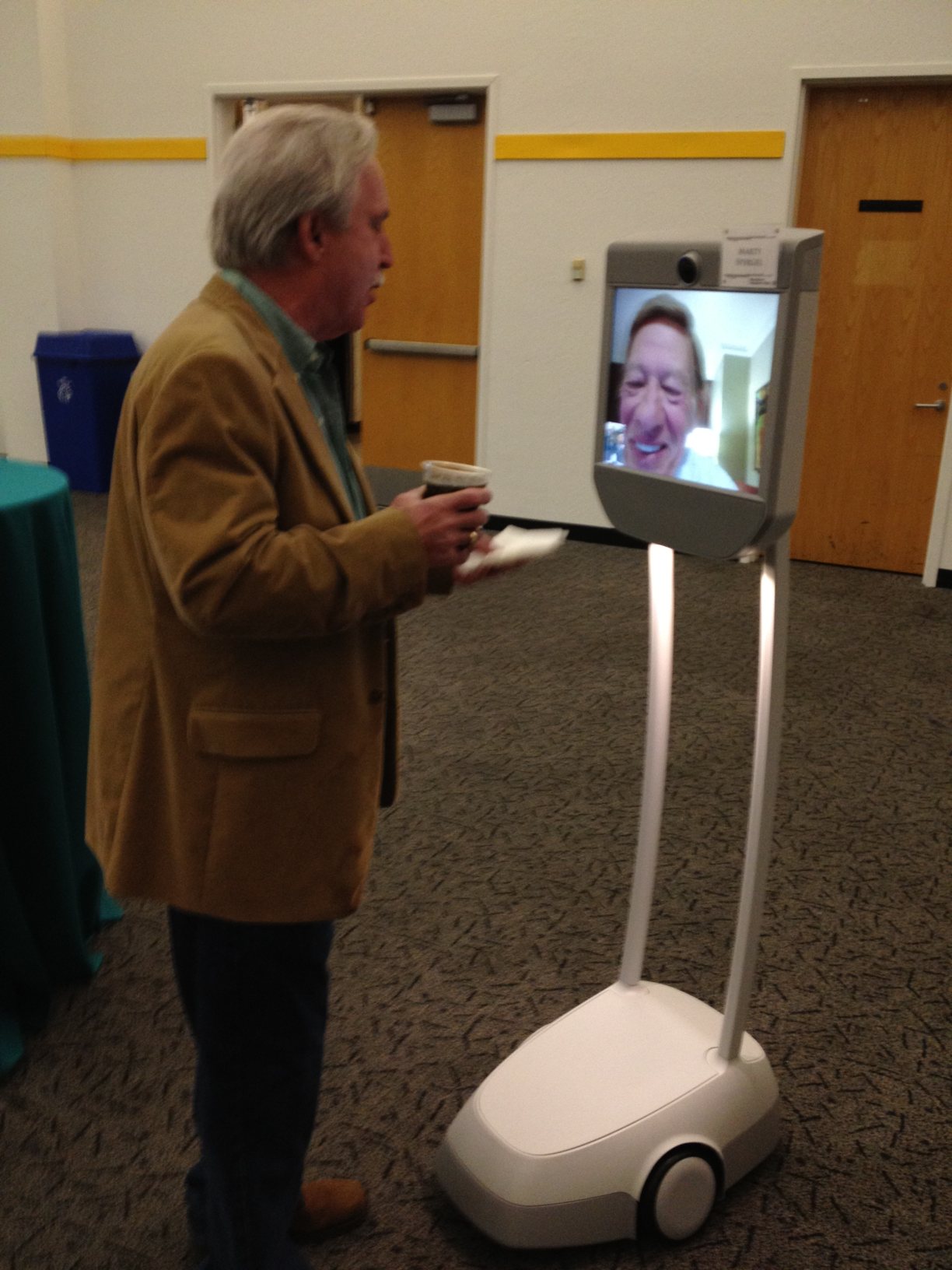
Steve Dompier brought in his original
radio which he used to play "Fool On the Hill" back in 1975 by picking
up radiated buss harmonics from an Altair. During the random access session
it was playing "Daisy":
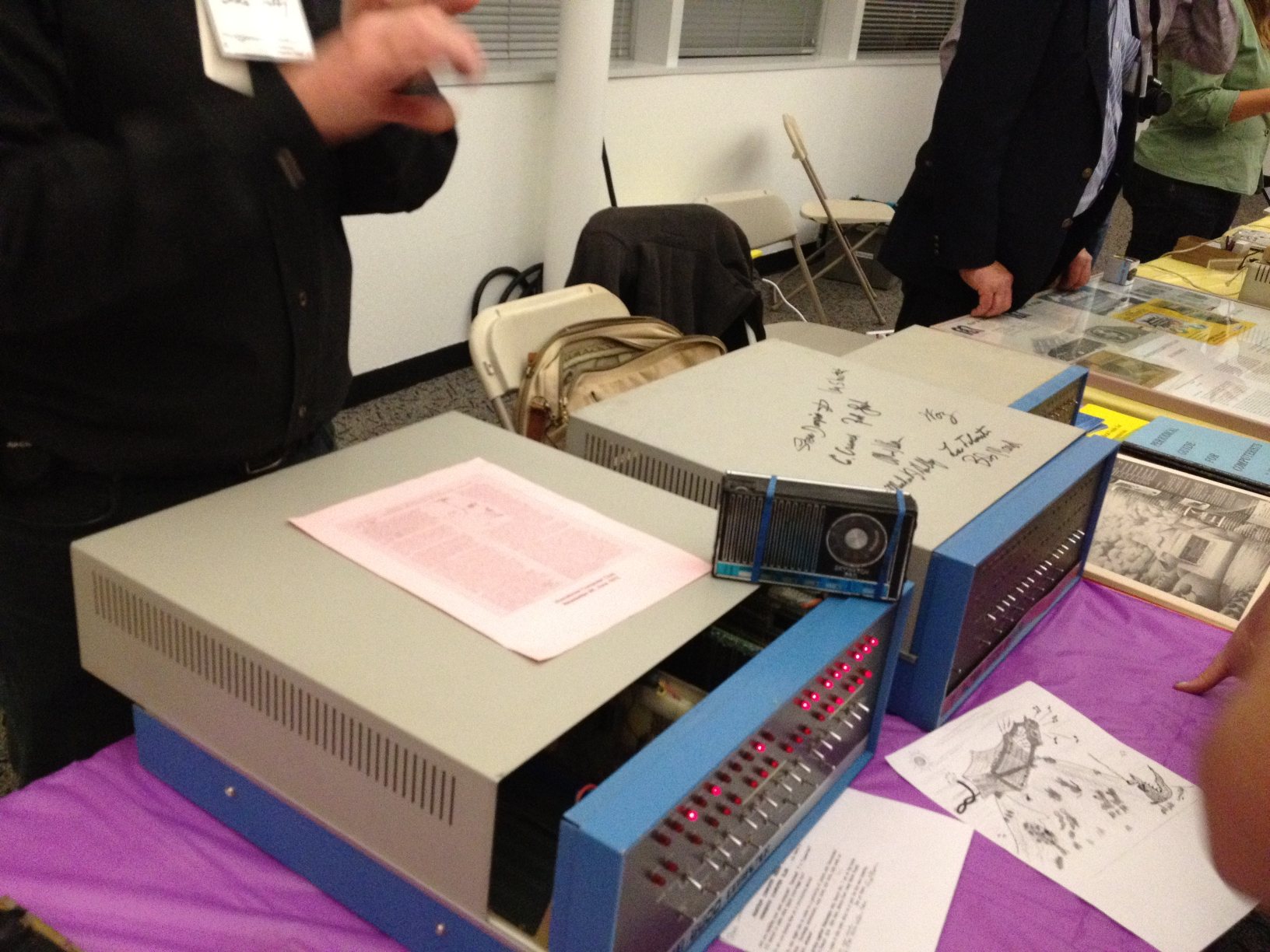
Eliot Lash is speaking here with Homebrewer Greg Dolkas (a larger image is here). I'm behind Eliot is this photo.
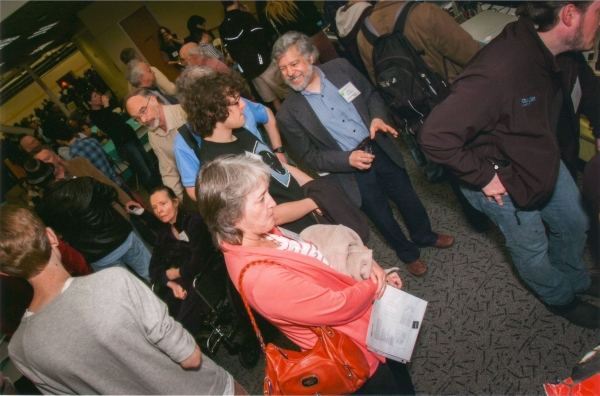
Mike Weise, Mark Thorson, Max Hauser, and Eliot Lash are examining a mysterious
piece of IBM equiment brought to the random access session by Mark. It
appears to be entirely electromechanical, and contains a dial that can be
adjusted from 1 to 80... perhaps related to Hollerith cards? If you happen
to know what it is, let us know.
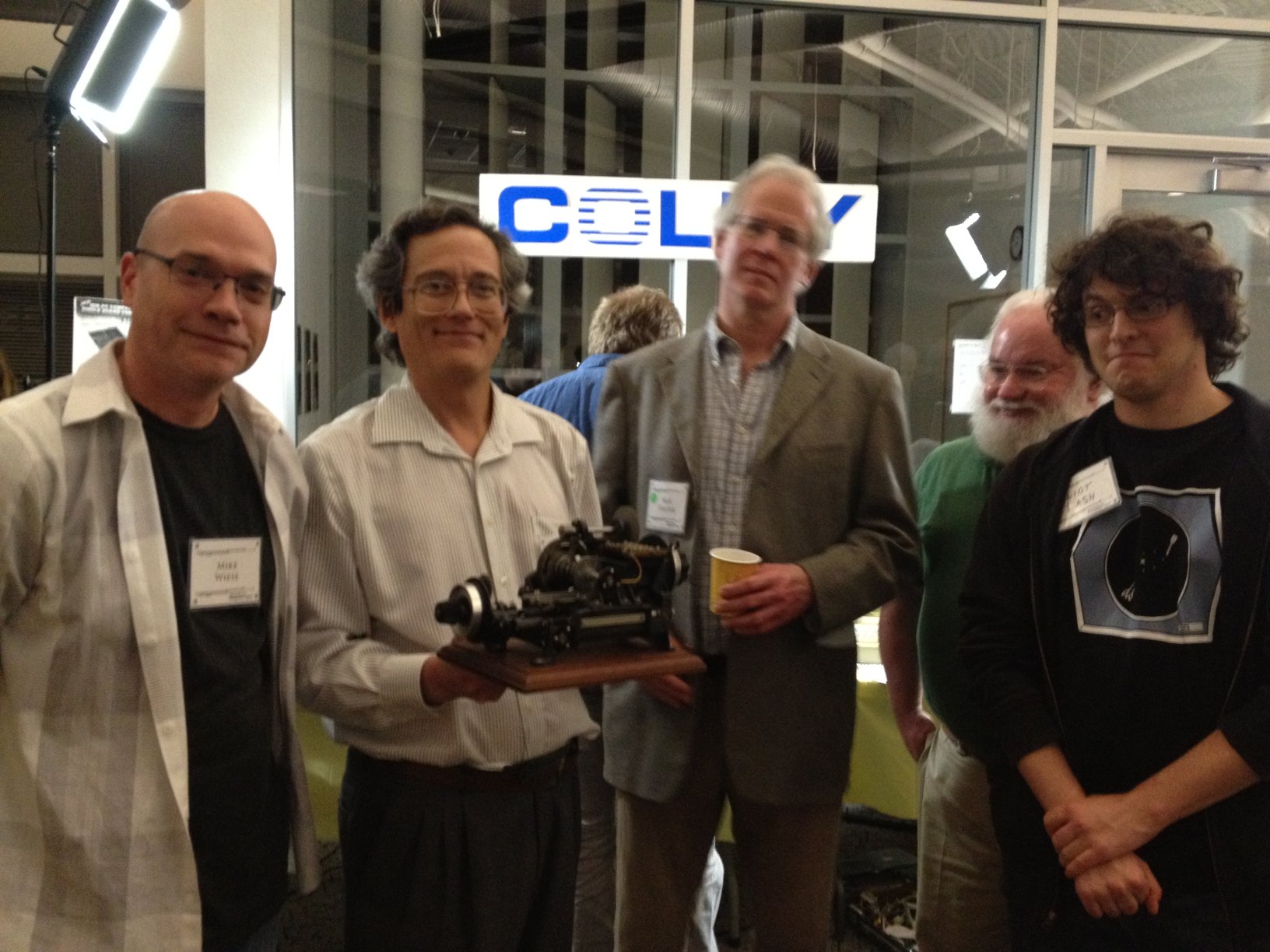
If you are nostalgic about the great computers of the past, be sure to
visit the Computer History Museum
in Mountain View, California. Here are some photos from my visit to their
original Moffitt Field location in July of 1999 along with Mike Fremont and
Mike Fox, which included a PDP-1, PDP-10, CRAY-1, CDC6600,
HP2100, IBM360, a later (solid state) UNIVAC, a section of the Whirlwind,
and even some of Lee Felsenstein's "Community Memory" machines!
Leonard Tramiel invited me over to see his original ATARI ST design
verification prototype, which was hand built. This unit was constructed
in 1984 (on general purpose wire-wrap breadboards which appear to have been
etched in 1983). He is planning on donating it to the Computer History
Museum.
If you are hankering to get into some really challenging hobby computer
projects, and are interested in astronomy, there is a new homebrew group of
sorts, called the Society of Amateur
Radio Astronomers. Mike Fremont and I are both members, and have
constructed our own amateur radio telescope called Project BAMBI (Bob and Mikes' Big Investment).
I am also helping an effort to rescue the Stanford
Radio Telescope Dishes.
I have done volunteering at the Computer History Museum as a member
of the PDP-1 Restoration
Project team.
My personal homepage is here.
 They said it was a "computer" and its name was the "PDP-1". A tall thin man
asked me to hit a key on a console to make a "decktape". I had absolutely
no idea what a "DEC tape" was at the time, but when I hit the key, a small
pair of reels BEGAN TO TURN!! It was a moment I would never forget.
They said it was a "computer" and its name was the "PDP-1". A tall thin man
asked me to hit a key on a console to make a "decktape". I had absolutely
no idea what a "DEC tape" was at the time, but when I hit the key, a small
pair of reels BEGAN TO TURN!! It was a moment I would never forget. 




 I wrote an assembler and compiler for it. The compiler was called
I wrote an assembler and compiler for it. The compiler was called 

 In 1974, Mike and I got swindled by ordering parts at prices that were "too
good to be true". This ad for "ECS" appeared in the September 9th, 1974 Electronic
News, which stated "The Catch: ... On teensey orders (under $500.00)
we expect payment in advance." Mike ordered an 8080 chip (costing hundreds
of dollars) which never arrived, and I ordered some 2602B 1K X 1 static RAM
chips, which DID arrive, but in dip packages with bottom painted part numbers
and the WRONG NUMBER OF PINS! I understand the "proprietor" left town.
In 1974, Mike and I got swindled by ordering parts at prices that were "too
good to be true". This ad for "ECS" appeared in the September 9th, 1974 Electronic
News, which stated "The Catch: ... On teensey orders (under $500.00)
we expect payment in advance." Mike ordered an 8080 chip (costing hundreds
of dollars) which never arrived, and I ordered some 2602B 1K X 1 static RAM
chips, which DID arrive, but in dip packages with bottom painted part numbers
and the WRONG NUMBER OF PINS! I understand the "proprietor" left town.  I then became the proud owner of a PDP 11/23-PLUS, running RT11 and MACRO-11.
If you enjoy the PDP-11, you can show your support by joining the
I then became the proud owner of a PDP 11/23-PLUS, running RT11 and MACRO-11.
If you enjoy the PDP-11, you can show your support by joining the 











